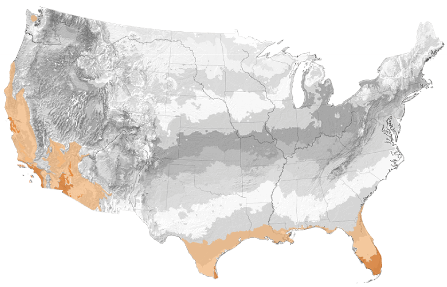You're growing in this Zip Code: 98109
Change LocationDiscover Plants for Your Area
Sago Palm
Cycas revoluta
Retailers Near You
No Retailers found within 100 miles of your zipcode
Be Inspired: How to Use this Plant
| Bloom Time | Prized for foliage. |
|---|---|
| Deciduous/Evergreen | Evergreen |
| Special Features | Easy Care, Waterwise |
| Problems/Solutions | Coastal Exposure, Deer Resistant |
| Growth Rate | Slow |
| Landscape Use | Container, Poolside |
| Design Ideas | Not a true palm, this plant is a living fossil that is technically part conifer and part fern! It is stiff and broad, making a reliable palm-like effect in shaded gardens where space is limited. Ideal in Asian compositions or in a fern grotto. Super in tropical gardens with other foliage plants and hot-colored flowers. Grow as a single specimen and avoid crowding as it destroys its symmetry. |
| Foliage Color | Green |
| Companion Plants | Canna (Canna); Plumbago (Plumbago); Foxtail Fern (Asparagus); Jacaranda (Jacaranda); Jatropha (Jatropha) |
| Care Instructions | Provide porous, loamy, very well-drained soil; avoid heavy, wet soils. Provide some shade in hottest regions. Water deeply, regularly in first few growing seasons to establish root system; take care not to overwater. Feed in early spring. Prune away old faded fronds close to trunk. Remove new plantlets at base of trunk. Not fit for human or animal consumption. |
| History | This very unique plant may be the most primitive living seed bearer on the face of the earth. Although it is called Sago Palm and may even look like a palm, it is classified as a gymnosperm along with the conifers. It inhabits its own family, Cycadaceae which contains but one genus, Cycas was classified by Linnaeus in the 18th century. He named it from the perpetual misnomer, from the Greek for palm tree. The genus contains about 40 species from the tropics of Southeast Asia and the Pacific. This species, the most commonly cultivated by far, is native to the southern Japanese islands of Ryuku and Satsuma. Its discovery and classification is attributed to Carl von Thunberg 1743-1828, who collected some of the first plants from Japan while there at the end of the 18th century. |
| Lore | The seeds that develop at maturity and the foliage of the Sago Palm are considered highly toxic to cats and dogs. |
| Bloom Time | Prized for foliage. |
|---|---|
| Deciduous/Evergreen | Evergreen |
| Special Features | Easy Care, Waterwise |
| Problems/Solutions | Coastal Exposure, Deer Resistant |
| Growth Rate | Slow |
Retailers Near You
No Retailers found within 100 miles of your zipcode
Retailers Near You
No Retailers found within 100 miles of your zipcode
Buy Online
We cannot currently ship this product to your zip code.
About Us
We have been pioneers and craftsmen in the art of growing plants for nearly
100 years. Since our founding in Southern California by Harry E. Rosedale, Sr.
in 1926, we have been absolutely dedicated and obsessed with quality.
We have been pioneers and craftsmen in the art of growing plants for nearly 100 years. Since our founding in Southern California by Harry E. Rosedale, Sr. in 1926, we have been absolutely dedicated and obsessed with quality.







